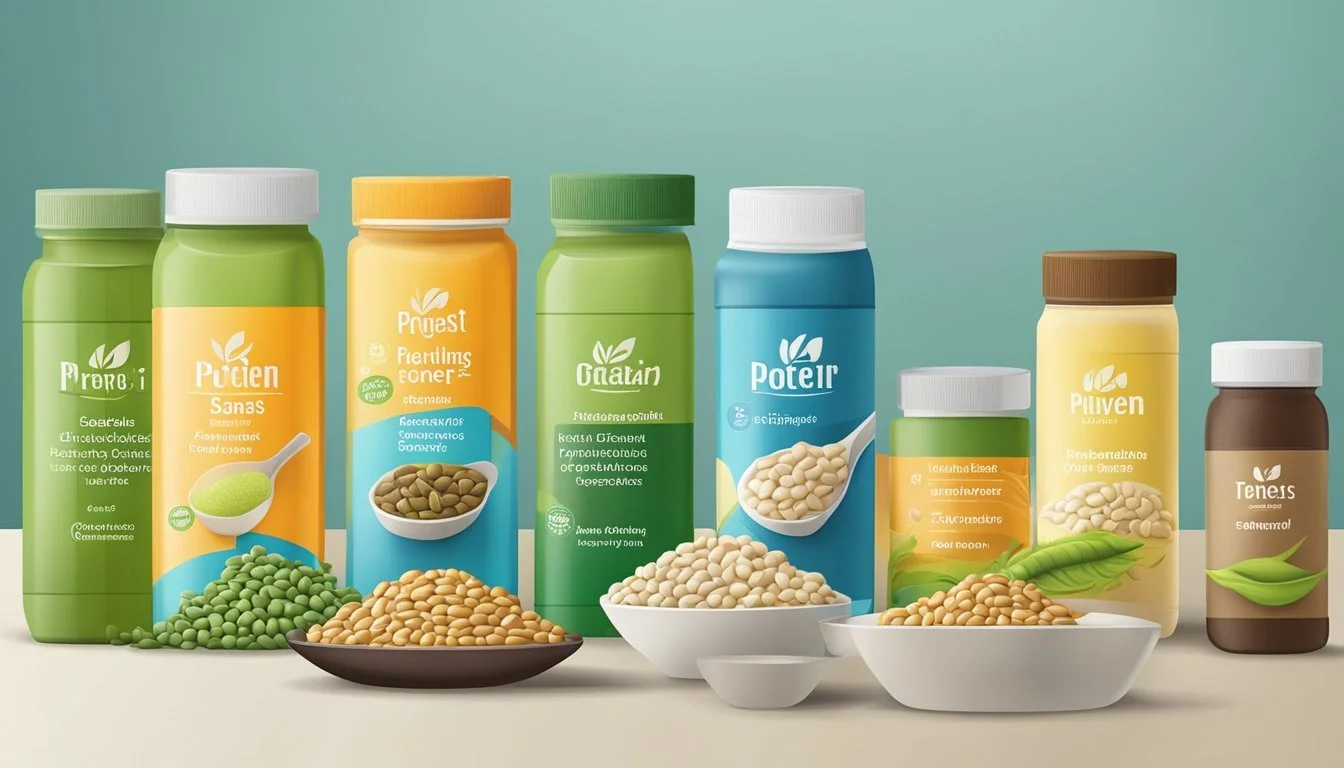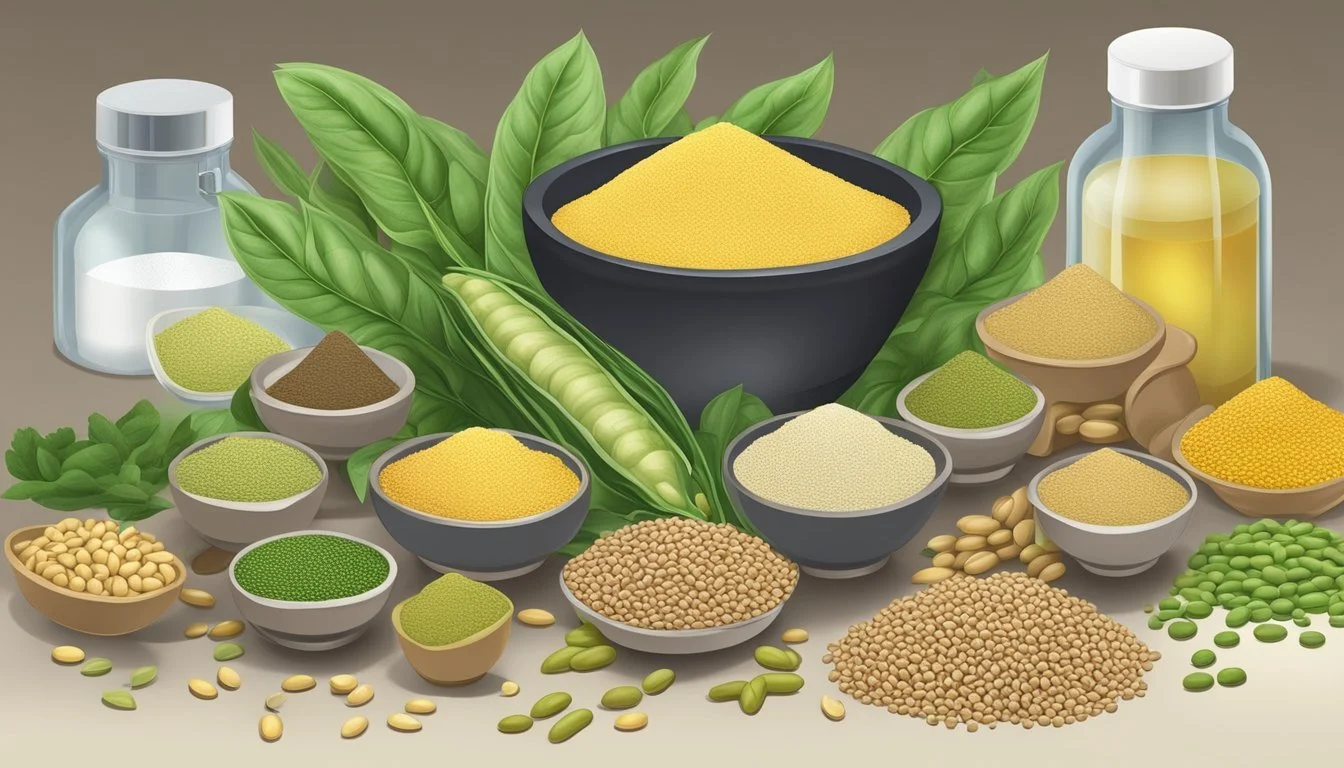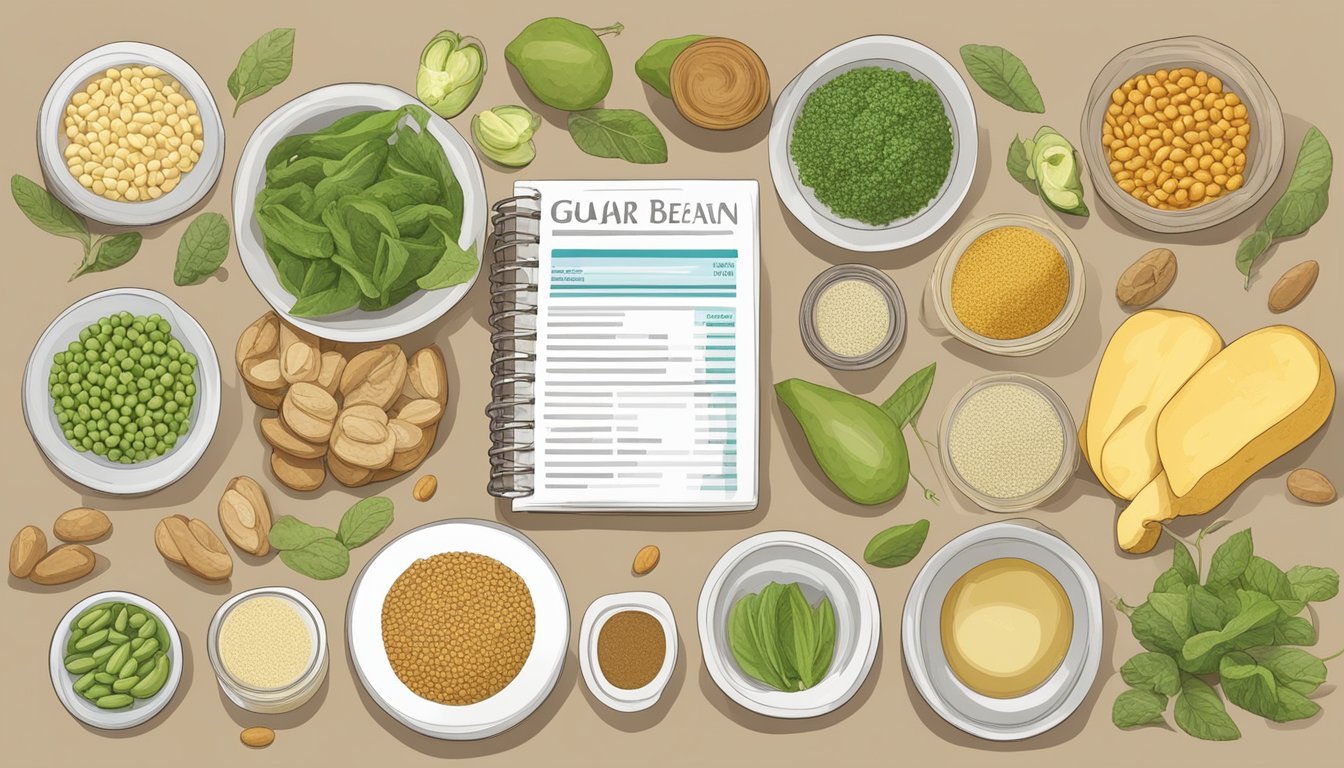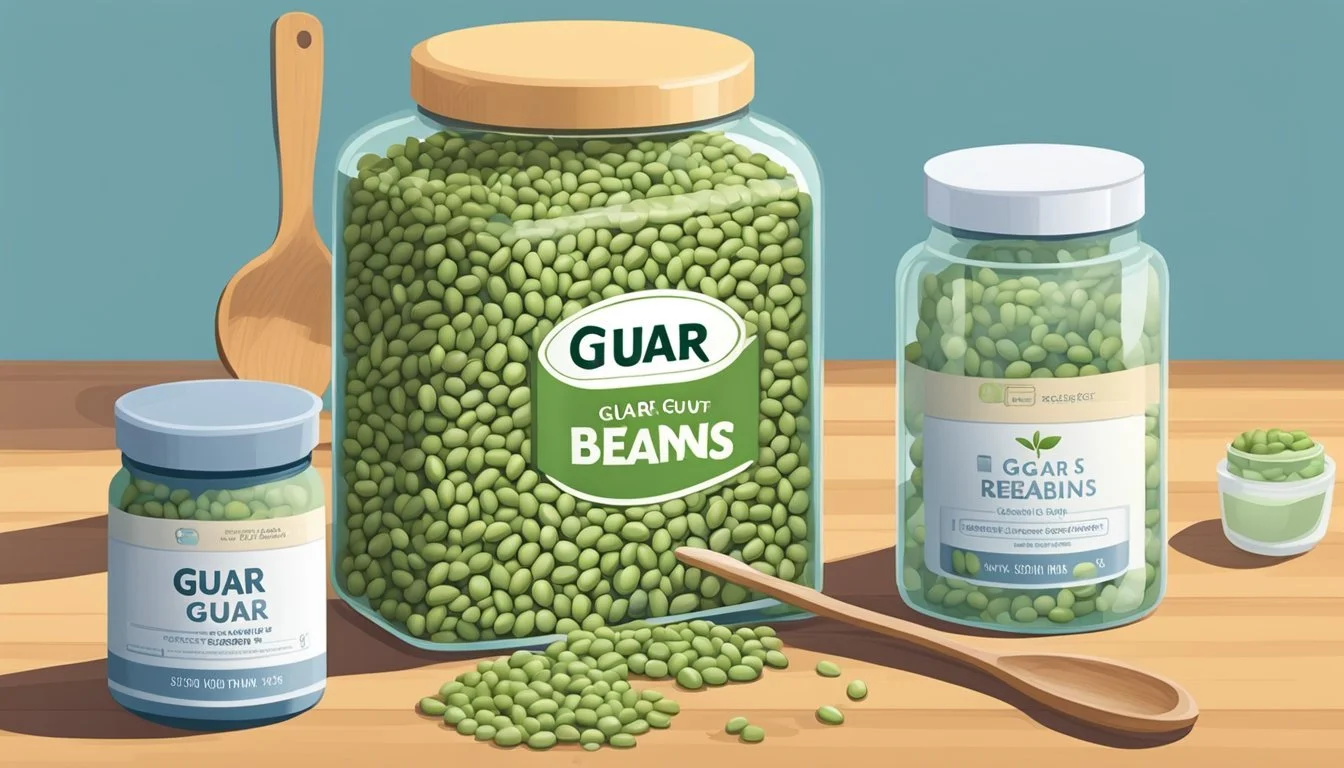Guar Beans Substitutes
Best Alternatives for Cooking and Baking
When it comes to finding substitutes for guar beans, many options are available that can serve as effective replacements in various recipes. Starches like tapioca, arrowroot, potato, and corn are some of the best alternatives to guar gum thanks to their similar binding and thickening properties. These substitutes can seamlessly integrate into your cooking, whether you're thickening a soup or stabilizing a dessert.
For those looking for more specialized alternatives, xanthan gum, agar agar, psyllium husk, and gelatin also serve as excellent choices. Each of these substitutes brings unique textures and benefits, making them highly versatile for different culinary needs.
Locust bean gum, chia seeds, and ground flaxseed offer additional options for those seeking to avoid guar gum. These ingredients not only act as effective binders but also add nutritional value to the dish, providing both functionality and health benefits in your recipes.
Overview of Guar Beans and Guar Gum
Guar beans are the source of guar gum, a versatile ingredient used in various industries. Its primary functions include thickening, binding, and stabilizing food products.
Origin and Uses of Guar Beans
Guar beans come from the leguminous plant Cyamopsis tetragonoloba, primarily grown in India. These beans are rich in protein and soluble fiber, making them valuable in nutrition as well as industrial applications.
In the food industry, guar beans are processed to extract guar gum, which is used as a thickener and binder. It helps improve texture and consistency in products like ice cream, yogurt, and sauces.
The use of guar beans extends to animal feed and traditional medicines, capitalizing on their high protein and nutrient content.
Properties of Guar Gum
Guar gum is a polysaccharide primarily composed of galactose and mannose. This structure gives it excellent hydration capabilities, allowing it to swell in cold water and form gels, which is crucial for its role as a thickener.
It is notable for being both a thickener and an emulsifier, making it ideal for keeping ingredients homogenized in processed foods.
Guar gum is also recognized for its high soluble fiber content, which offers health benefits like improved digestive health and cholesterol levels.
Reasons for Substituting Guar Gum
Guar gum, while effective as a thickening and stabilizing agent, may not suit everyone's dietary needs or taste preferences. Alternatives can address dietary restrictions, allergies, and even differences in texture or flavor.
Dietary Restrictions and Allergies
Guar gum may not be suitable for individuals with allergies or specific dietary restrictions. People with legume allergies, for instance, should avoid guar gum as it is derived from guar beans.
Moreover, some individuals may experience gastrointestinal issues when consuming guar gum. Vegan and gluten-free alternatives like xanthan gum, chia seeds, and agar agar offer safer options for those with specific health needs.
Substitutes such as psyllium husk and arrowroot powder are often available in grocery stores and are also hypoallergenic. These alternatives can ensure that dishes remain allergy-free and cater to a broader audience.
Variability in Texture and Flavor
The texture and flavor imparted by guar gum may not always align with the desired outcome in recipes. Guar gum can sometimes produce a slimy texture, which might not be desirable in all dishes.
Using substitutes like gelatin or egg whites can result in a creamier consistency better suited for certain desserts. Chia seeds offer a more natural, gel-like consistency, making them an excellent option for puddings and sauces. For those seeking a neutral taste, arrowroot powder or tapioca starch can be ideal choices.
Cost considerations may also lead individuals to seek out more affordable alternatives like cornstarch, which can be more readily available and less expensive than guar gum. Each substitute has its unique properties, making it essential to choose the most suitable one based on the specific culinary requirement.
Starch-Based Substitutes for Guar Gum
Starch-based substitutes such as cornstarch, tapioca starch, potato starch, and arrowroot powder offer excellent alternatives to guar gum in various culinary applications. They serve different purposes from thickening sauces to stabilizing soups and dressings.
Cornstarch as a Thickener
Cornstarch is frequently used as a thickener for gravies, soups, and sauces. It is derived from the endosperm of corn kernels. When mixed with a cold liquid before adding to hot, it prevents clumping and creates a smooth consistency.
Using cornstarch requires a typical ratio of one tablespoon of cornstarch to one cup of liquid. This substitute not only thickens but also lends a slight gloss to the end product, making it suitable for both savory and sweet dishes.
Tapioca Starch's Role in Recipes
Tapioca starch, derived from the cassava root, is known for its elasticity and clear gel formation in cooking. It excels in binding and thickening, making it an excellent choice for pie fillings, puddings, and sauces.
It’s particularly useful in recipes needing a glossy finish and can withstand freezing and reheating without losing its consistency. Use about 1.5 teaspoons of tapioca starch for every tablespoon of guar gum required, adjusting based on the recipe.
Potato Starch in Cooking
Potato starch is another versatile alternative to guar gum, especially in gluten-free baking and recipes requiring high heat processing. Extracted from crushed potatoes, it has a neutral taste and a fine texture.
It’s an efficient thickening agent suitable for soups, stews, and custards. The typical usage ratio is one tablespoon of potato starch to one cup of liquid. Potato starch not only thickens but also adds a velvety texture to the dishes.
Arrowroot Powder Applications
Arrowroot powder, obtained from tropical plant roots, is well-regarded for its clear, glossy appearance and neutral taste. It’s an excellent thickener for gravies, sauces, and dressings, providing a smooth finish without cloudiness.
Arrowroot is particularly effective in acidic recipes and doesn’t break down under acidic conditions like other starches. To substitute for guar gum, use a ratio of 2 teaspoons of arrowroot powder per tablespoon of guar gum. It’s also gluten-free, making it suitable for those with dietary restrictions.
Protein-Based Alternatives
Protein-based alternatives to guar beans can offer different benefits depending on their source. Gelatin, agar agar, and collagen-rich substitutes each bring unique qualities to recipes and can be suitable for various culinary uses.
Gelatin as a Versatile Substitute
Gelatin, derived from animal collagen, is widely used in both culinary and non-culinary applications. It comes in forms such as gelatin powder and unflavored gelatin.
Gelatin is especially effective in thickening and stabilizing. It is commonly used in desserts like jellies, marshmallows, and gummies to provide structure. Besides desserts, it also plays a role in savory dishes like aspics.
To use gelatin, dissolve it in warm water. This step ensures it mixes well with other ingredients. Since it is a protein-based product, it can add a slight protein boost to recipes.
Agar Agar: The Seaweed Solution
Agar agar, extracted from red algae, is a popular vegan alternative. This seaweed-based substitute is available as agar agar powder or agar flakes.
Agar agar works as a gelling and thickening agent, similar to gelatin, but it's plant-based. It's ideal for recipes that require a firm structure, like vegan jellies, puddings, and custards. Agar agar sets at room temperature, making it convenient for desserts that need to stay solid without refrigeration.
When substituting agar agar for gelatin, use slightly less agar agar powder compared to gelatin powder due to its stronger gelling properties.
Collagen-Rich Substitutes
Collagen itself, available as a supplement, can serve as an alternative in some recipes. Collagen-rich products are typically sourced from animal collagen and offer health benefits alongside culinary uses.
These substitutes excel in recipes needing thickening and binding, similar to gelatin, though it's not a direct replacement for gelatin in all applications. Adding collagen to soups, broths, and smoothies can enhance the protein content.
Sourcing high-quality, unflavored collagen is key to avoiding unwanted flavors in dishes.
Substitute Source Forms Available Key Uses Gelatin Animal Gelatin powder Desserts, aspics Agar agar Red algae Agar agar powder Vegan jellies, puddings Collagen Animal Collagen powder Soups, smoothies
Fiber and Seed-Based Alternatives
When considering alternatives to guar beans, fiber and seed-based options offer notable benefits. These not only serve as effective substitutes but also provide additional nutritional advantages like improved digestive health and increased dietary fiber.
Psyllium Husk's Health Benefits
Psyllium husk is a popular gelatin substitute rich in soluble fiber. It is effective in treating and preventing constipation and diarrhea due to its ability to absorb water and form a gel-like substance. This aids in creating bulk in the intestines and promotes smoother bowel movements.
Additionally, psyllium husk can help regulate blood sugar levels and lower cholesterol. A small amount, mixed with water, can be incorporated into baked goods to enhance texture and fiber content without altering flavor.
Chia Seeds for Added Nutrition
Chia seeds are another excellent alternative, famous for their high soluble fiber and nutrient content. When soaked, they form a gel, making them suitable for thickening recipes and creating a smoother consistency in liquid-based dishes.
Chia seeds are also packed with omega-3 fatty acids, antioxidants, and proteins, providing a nutritional boost. These seeds can be used whole or ground, making them versatile. Simply adding a tablespoon to smoothies, puddings, or as an egg replacement in baking can elevate both texture and health benefits.
Flaxseeds: The Nutty Alternative
Flaxseeds, particularly when ground, offer a nutty flavor and a wealth of nutrients, including soluble fiber and omega-3 fatty acids. Similar to chia seeds, ground flaxseed can be used as a thickening agent or as an egg replacer in various baking recipes.
To maximize their benefits, it's crucial to use ground flaxseeds since whole flaxseeds pass through the digestive system without releasing their full nutritional potential. Adding them to yogurt, oatmeal, or smoothies is a simple way to enhance one's diet with an added fiber and nutrient boost.
Additional Synthetic and Natural Substitutes
When looking for guar bean substitutes, several synthetic and natural options provide versatile, effective alternatives in various culinary and food manufacturing applications. Below are some noteworthy substitutes, each with unique properties and uses.
Xanthan Gum and Its Versatility
Xanthan gum is a popular choice for replacing guar gum because of its ability to act as a binder, stabilizer, and emulsifying agent. It is produced through the fermentation of sugars by the bacterium Xanthomonas campestris. This gum is especially useful in gluten-free baking, where it helps improve the texture of baked goods and prevents ingredients from separating.
Applications include:
Gluten-free baking: Provides elasticity and structure.
Sauces and dressings: Enhances thickness and stability.
Beverages: Maintains uniform texture.
Pectin for Fruit Preparations
Pectin, naturally found in fruits, serves as an excellent gelling agent, especially in fruit-based recipes. It is frequently used in making jams, jellies, and fruit preserves. Pectin powder helps to create a firm texture and can also act as a stabilizer in various desserts and dairy products.
Key uses:
Jams and jellies: Creates a stable gel.
Desserts: Adds firmness to puddings and custards.
Yogurt and dairy: Stabilizes and improves texture.
Carrageenan from Seaweed
Derived from red seaweed, carrageenan is another good substitute for guar gum. It is often used to thicken and stabilize dairy and plant-based milk products. This gum is unique because it can create a range of textures from soft gels to firm, depending on the specific type used.
Prominent applications:
Dairy products: Thickens and prevents separation.
Plant-based beverages: Emulsifies and stabilizes.
Desserts: Forms gels in puddings and custards.
Locust Bean Gum in Vegan Cooking
Locust bean gum, extracted from the seeds of the carob tree, acts primarily as a thickener, stabilizer, and emulsifier. It is especially valued in vegan cooking for its ability to replace gelatin in recipes. This makes it a great option for those following vegetarian or vegan diets.
Uses include:
Ice cream: Prevents crystallization and improves texture.
Yogurt: Stabilizes and thickens.
Vegan and vegetarian recipes: Serves as a gelatin substitute for creating gel-like textures.
Practical Application and Cooking Tips
When using substitutes for guar beans, it is crucial to understand how each option affects recipes regarding texture, consistency, and measurements. Below are detailed guidelines on choosing and using these substitutes effectively in various culinary applications.
Substitutes in Baking and Desserts
In gluten-free baking, potato starch and arrowroot powder are excellent choices. They ensure a suitable texture without compromising the recipe's integrity. Potato starch works well in moist cakes and cookies. It is ideal for thickening sauces, ice creams, and puddings due to its neutral taste.
For those looking for vegan alternatives, agar agar powder and chia seeds are indispensable. Agar agar powder can replace guar gum in custards, jellies, and other desserts that require a firm set. Chia seeds, when soaked in liquid, form a gel-like substance, serving as a great binding agent in eggless recipes.
Consistency and Texture Modifications
Altering the consistency and texture of recipes using guar gum substitutes requires careful consideration. Egg whites provide a similar texture and binding capability suitable for light and airy baked goods. They are best used in meringues, soufflés, and gluten-free cakes.
Xanthan gum is a robust alternative to guar gum, especially in sauces, soups, and gravies. Like guar gum, it prevents ingredient separation and enhances viscosity. For dairy-free products, locust bean gum is optimal, maintaining creaminess in vegan ice creams and yogurts.
Substitution Ratios and Measurements
Accurate measurements are vital when substituting guar gum to avoid altering the recipe's balance. Typically, xanthan gum can replace guar gum in a 1:1 ratio. For every teaspoon of guar gum, use an equal amount of xanthan gum.
When using chia seeds, the ratio is generally 1 part chia seeds to 9 parts water. Allow the mixture to sit for about 15 minutes to form a gel before incorporating it into the recipe.
For agar agar powder, 1 teaspoon can replace 1 teaspoon of guar gum, but the mixture should be boiled until fully dissolved. Arrowroot powder and potato starch require slightly more, often used at 1.5:1 to guarantee the same thickening effect.
Using tables or lists to determine these substitution ratios and modifications will be beneficial in precision cooking.
Health Considerations and Dietary Impact
Guar bean substitutes can impact digestive health and are suitable for those on gluten-free diets. Understanding these aspects helps in choosing the right alternatives.
Effect on Digestive Health
Guar beans and their substitutes such as potato starch and cassava root are rich in dietary fiber. This fiber plays a crucial role in promoting digestive health. However, excessive consumption of these fibers can sometimes result in digestive issues like gas, bloating, or stomach discomfort.
Cassava root and flour offer mild alternatives suitable for those sensitive to high fiber. Both are less likely to cause digestive distress in moderate amounts. Vegan diets benefit from these substitutes as they fit well with plant-based eating without compromising gut health.
Addressing Gluten-Free Dietary Needs
For those with gluten intolerance or celiac disease, choosing suitable substitutes for guar beans is essential. Potato starch and cassava flour are excellent options. They provide similar thickening properties in baking and cooking without the gluten-related issues.
These substitutes not only cater to gluten-free needs but also contribute to the variety in a restricted diet. Cassava flour, being versatile and easily digestible, is particularly preferred. These ingredients ensure that gluten-free recipes maintain their desired texture and consistency, making them a valuable addition to such diets.
Sourcing and Availability of Substitutes
When looking for substitutes for guar beans, options can be found both in physical grocery stores and online. Availability may vary depending on geographical location and local demand.
Finding Substitutes in Grocery Stores
In many grocery stores, you can find suitable substitutes for guar beans such as potato starch, tapioca flour, and locust bean gum. These are often located in the baking or gluten-free sections.
Health food stores and larger supermarkets may also carry vegan substitutes and specialty thickeners like agar agar. For those looking for gluten-free options, potato starch and tapioca flour are commonly available and are good alternatives for baking and cooking needs.
Online Shopping Options
Online retailers offer a wide range of guar bean substitutes, with availability often surpassing what you might find locally. Websites like Amazon and specialty health food stores provide numerous options including potato starch, tapioca flour, and locust bean gum.
Buying online can be particularly advantageous for finding more niche products such as agar agar and other specialty vegan substitutes. Several sellers offer bulk purchasing options, which can be cost-effective for frequent use. Checking reviews and ratings can also help ensure the quality and reliability of the products.
Conclusion
When looking for substitutes for guar beans, several alternatives offer similar properties in various culinary applications.
Potato Starch stands out as an excellent option for gluten-free baking and thickening sauces, soups, and custards.
Locust Bean Gum, derived from the carob tree, is another viable alternative. It acts as a thickener, emulsifier, and stabilizer, especially in processed foods like ice cream and yogurt.
For those needing a plant-based option, Agar Agar can be substituted with cassava flour. Cassava flour is gluten-free and does not alter the flavor of dishes.
Each substitute brings unique benefits, allowing for flexibility in recipes. Whether it's baking, thickening, or stabilizing, these substitutes ensure similar results without compromising quality.








